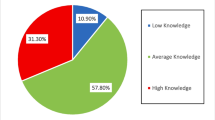Abstract
Summary
We measured osteoporosis knowledge in an older adult population with minimal trauma fracture. At follow-up, health literacy and osteoporosis knowledge had not changed significantly from baseline, and 14 (23 %) patients reported not taking any osteoporosis medication. Current osteoporosis care does not result in increased patient knowledge about their disease.
Introduction
We aimed to measure health literacy and osteoporosis knowledge in an older adult population with minimal trauma fracture (MTF).
Methods
A cohort study with 3-month follow-up in Australia was conducted. Participants were hospital admissions with an MTF confirmed by X-ray. Main outcomes were the Rapid Estimate of Adult Literacy in Medicine (REALM) and Osteoporosis Knowledge Assessment Tool (OKAT) scores. Supplementary data about osteoporosis knowledge, medication use and family practitioner visits regarding osteoporosis were obtained.
Results
Complete data are available in 60 participants. On admission, 97 % participants had high REALM scores [mean (range) 64.7 (46.66)] and low OKAT scores [8.83 (2.16)]. At follow-up, three (5 %) participants had a further fracture. REALM and OKAT scores had not changed significantly from baseline. There was no association between OKAT score at follow-up and current treatment for osteoporosis, beliefs relating to treatment or bone health, and discussion with health care worker since discharge after adjusting for Mini Mental State Examination score. Health literacy or reading ability was not related to OKAT score.
Conclusions
Osteoporosis knowledge assessed by the OKAT did not improve in the 3 months after MTF in this cohort of literate older adults, although there was some evidence of improvements in health beliefs. Current care in osteoporosis does not increase patient knowledge about their disease adequately which may impair patient effectiveness in obtaining appropriate treatment.
Similar content being viewed by others
References
Access Economics Pty Limited (2006) Breaking Point: the economic cost of not adhering to bisphosphonate treatment for osteoporosis. http://anzbms.org.au/news/documents/Breaking_point_Oct-06.pdf. Accessed 30 March 2012
Elliot-Gibson V, Bogoch ER, Jamal SA, Beaton DE (2004) Practice patterns in the diagnosis and treatment of osteoporosis after a fragility fracture: a systematic review. Osteoporos Int 15:767–778
Kelly AM, Clooney M, Kerr D, Ebeling PR (2008) When continuity of care breaks down: a systems failure in identification of osteoporosis risk in older patients treated for minimal trauma fractures. Med J Aust 188:389–391
Little EA, Eccles PE (2010) A systematic review of the effectiveness of interventions to improve post-fracture investigations and management of patients at risk of osteoporosis. Implement Sci 5:80
Kaufman JD, Bolander ME, Bunta AD et al (2003) Barriers and solutions to osteoporosis care in patients with a hip fracture. J Bone Joint Surg Am 85-A:1837–1843
Premaor MO, Pilbrow L, Tonkin C et al (2010) Low rates of treatment in postmenopausal women with a history of low trauma fractures: results of audit in a Fracture Liaison Service. QJM 103:33–40
Levinson MR, Clay FJ (2009) Barriers to the implementation of evidence in osteoporosis treatment in hip fracture. Intern Med J 39:199–202
Deinzer R, Micheelis W, Granrath N, Hoffmann T (2009) More to learn about: periodontitis-related knowledge and its relationship with periodontal health behaviour. J Clin Periodontol 36:756–764
Torres RY, Marks R (2009) Relationships among health literacy, knowledge about hormone therapy, self-efficacy, and decision-making amongst postmenopausal health. J Health Comm 14:43–55
Kimber CM, Grimmer-Somers KA (2009) Multifaceted guideline implementation strategies improve early identification and management of osteoporosis. Aust Health Rev 33:423–433
Patel VP, Mathew R, Raptis D, Christofi T, Youngman J (2010) Overcoming barriers to secondary prevention in hip fracture patients: an electronic referral and management system for osteoporosis. Injury 41:1249–1255
Switzer JA, Jaglal S, Bogoch ER (2009) Overcoming barriers to osteoporosis care in vulnerable elderly patients with hip fractures. J Orthop Trauma 23:454–459
Folstein MF, Folstein SE, McHugh PR (1975) Mini-mental state. A practical method for grading the cognitive state of patients for the clinician. J Psychiatr Res 12:189–198
Davis TC, Long SW, Jackson RH et al (1993) Rapid estimate of adult literacy in medicine: a shortened screening instrument. Fam Med 25:391–395
Winzenberg TM, Oldenburg B, Frendin S, Jones G (2003) The design of a valid and reliable questionnaire to measure osteoporosis knowledge in women: the Osteoporosis Knowledge Assessment Tool (OKAT). BMC Musculoskelet Disord 24:17
Cadarette SM, Gignac MA, Beaton DE, Jaglal SB, Hawker GA (2007) Psychometric properties of the “Osteoporosis and You” questionnaire: osteoporosis knowledge deficits among older community-dwelling women. Osteoporos Int 18:981–989
Australian Bureau of Statistics (2008) Adult literacy and life skills survey, summary results, Australia, 2006 (Reissue) 4228.06. http://wwwausstatsabsgovau/ausstats/subscribernsf/0/B22A471C221C7BADCA2573CA00207F10/$File/42280_2006%20(reissue)pdf. Accessed 30 March 2012
Barber MN, Staples M, Osborne RH et al (2009) Up to a quarter of the Australian population may have suboptimal health literacy depending upon the measurement tool: results from a population-based survey. Health Prom Int 24:252–261
Smith SK, Dixon A, Trevena L, Nutbeam D, McCaffery KJ (2009) Exploring patient involvement in healthcare decision making across different education and functional health literacy groups. Soc Sci Med 69:1805–1812
Williams B, Cullen L, Barlow JH (2002) “I never realised how little I knew!”: a pilot study of osteoporosis knowledge, beliefs and behaviours. Health Care Women Int 23:344–350
Lambert S, Loiselle C (2007) Health information seeking behavior. Qual Health Res 17:1006–1019
Elwyn G, Miron-Shatz T (2010) Deliberation before determination: the definition and evaluation of good decision making. Health Expect 13:139–147
Elder CA, Barber MN, Staples MP et al. (2012) Assessing health literacy: a new domain for collaboration between language testers and health professionals. Lang Assess Q (in press)
Sponsor’s role
We would like to thank our sponsors, the Helen Macpherson Smith Trust for their generous financial support of this research. Our sponsors played no role in the design of the study, in participant recruitment, data collection, analysis or preparation of this paper.
Conflicts of interest
None.
Author information
Authors and Affiliations
Corresponding author
Rights and permissions
About this article
Cite this article
Levinson, M.R., Leeuwrik, T., Oldroyd, J.C. et al. A cohort study of osteoporosis health knowledge and medication use in older adults with minimal trauma fracture. Arch Osteoporos 7, 87–92 (2012). https://doi.org/10.1007/s11657-012-0084-1
Received:
Accepted:
Published:
Issue Date:
DOI: https://doi.org/10.1007/s11657-012-0084-1




